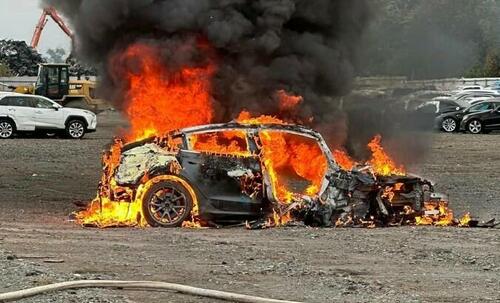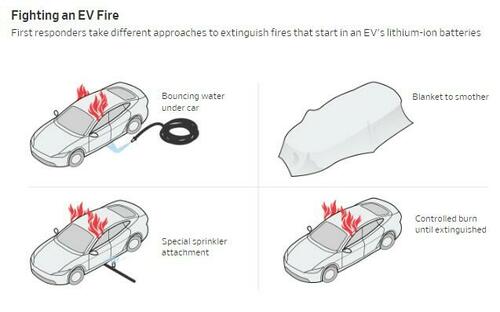
Firefighting is a whole new game in the electric vehicle era.
In fact, departments across the U.S. are finding out that the best way to "fight" such fires are to simply let them burn, according to a new report by the the Wall Street Journal.
The report points out that EV fires, unlike traditional gas-fueled car fires, are more enduring, challenging to extinguish, and prone to reigniting, according to firefighters and experts.
It also cites and example from Franklin, Tenn., where first responders encountered a Nissan Leaf EV fire in September, which required 45,000 gallons of water to douse, significantly more than the 500 to 1,000 gallons typically needed for gasoline vehicle fires.
Fire Marshal Andy King stated: “I think if we were faced with a similar scenario next time, we might need to let it burn."

The Journal reported that in the U.S., over 170,000 vehicle fires occur annually. However, the National Fire Protection Association, relying on federal data, doesn't categorize these fires by the vehicles' power source.
Tesla claims its cars have a much lower fire incidence compared to the national average, a finding echoed by some independent studies regarding EVs in general.
Michael O’Brian, fire chief of Michigan’s Brighton Area Fire Authority and chair of the International Association of Fire Chiefs’ battery committee, told WSJ: “When we look at how much money is going into battery plants, into the EV transition, there hasn’t been that carve-out to prepare the fire service.”
EV fires typically originate in the car's lithium-ion batteries, which hold vast energy. According to UL Solutions' chief scientist Robert Slone, these fires can start due to poor design, damage, or internal lithium build-up causing "thermal runaway."
These batteries, containing combustible chemicals and self-oxygenating properties, can reignite long after being extinguished. Tom Miller, an instructor at West Virginia University Fire Service Extension and the National Volunteer Fire Council, highlights that these fires also release extremely toxic fumes.
Fire departments are adapting to electric vehicle (EV) fires, which often originate in lithium-ion batteries. In New Jersey and California, firefighters let Teslas burn out after accidents, as water can be ineffective against battery fires, the Journal wrote.
Some firefighters are exploring techniques like using fog streams to cool fires enough to move the vehicle. New technologies, such as specialized nozzles and fire-suppressing batteries, are being developed to address these challenges.
The National Fire Protection Association recommends additional safety measures, like sprinklers in parking garages, to counteract the increased fire risks from modern vehicles. Meanwhile, car manufacturers and suppliers are working on innovations like early warning sensors and materials to contain battery fires, and research into solid-state batteries is ongoing.
Regardless, firefighting organizations continue to seek effective strategies for dealing with EV fires, with new guidelines expected in the near future.
Firefighting is a whole new game in the electric vehicle era.
In fact, departments across the U.S. are finding out that the best way to “fight” such fires are to simply let them burn, according to a new report by the the Wall Street Journal.
The report points out that EV fires, unlike traditional gas-fueled car fires, are more enduring, challenging to extinguish, and prone to reigniting, according to firefighters and experts.
It also cites and example from Franklin, Tenn., where first responders encountered a Nissan Leaf EV fire in September, which required 45,000 gallons of water to douse, significantly more than the 500 to 1,000 gallons typically needed for gasoline vehicle fires.
Fire Marshal Andy King stated: “I think if we were faced with a similar scenario next time, we might need to let it burn.”

The Journal reported that in the U.S., over 170,000 vehicle fires occur annually. However, the National Fire Protection Association, relying on federal data, doesn’t categorize these fires by the vehicles’ power source.
Tesla claims its cars have a much lower fire incidence compared to the national average, a finding echoed by some independent studies regarding EVs in general.
Michael O’Brian, fire chief of Michigan’s Brighton Area Fire Authority and chair of the International Association of Fire Chiefs’ battery committee, told WSJ: “When we look at how much money is going into battery plants, into the EV transition, there hasn’t been that carve-out to prepare the fire service.”
EV fires typically originate in the car’s lithium-ion batteries, which hold vast energy. According to UL Solutions’ chief scientist Robert Slone, these fires can start due to poor design, damage, or internal lithium build-up causing “thermal runaway.”
These batteries, containing combustible chemicals and self-oxygenating properties, can reignite long after being extinguished. Tom Miller, an instructor at West Virginia University Fire Service Extension and the National Volunteer Fire Council, highlights that these fires also release extremely toxic fumes.
Fire departments are adapting to electric vehicle (EV) fires, which often originate in lithium-ion batteries. In New Jersey and California, firefighters let Teslas burn out after accidents, as water can be ineffective against battery fires, the Journal wrote.
Some firefighters are exploring techniques like using fog streams to cool fires enough to move the vehicle. New technologies, such as specialized nozzles and fire-suppressing batteries, are being developed to address these challenges.
The National Fire Protection Association recommends additional safety measures, like sprinklers in parking garages, to counteract the increased fire risks from modern vehicles. Meanwhile, car manufacturers and suppliers are working on innovations like early warning sensors and materials to contain battery fires, and research into solid-state batteries is ongoing.
Regardless, firefighting organizations continue to seek effective strategies for dealing with EV fires, with new guidelines expected in the near future.
Loading…







